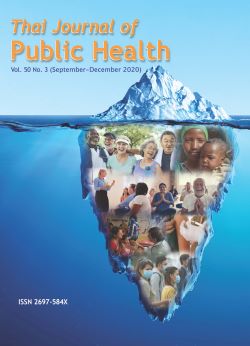Development of a New Tuberculosis Patient Care System at Singburi Hospital, Thailand
Keywords:
Development system, Tuberculosis care, Success rates of TB-treatmentAbstract
Singburi hospital recognizes the importance of systematic solutions for ongoing tuberculosis (TB) patient care, based on the standards and quality of care which cover a system of services. This study was carried out as research and development with the purpose of developing and evaluating patient outcomes within the TB care system for continuous quality improvement.
The ethics board of Singburi hospital approved this study. Purposive sampling was used to select two groups: before and after. The before group received TB treatment between 1 January 2018 and 28 February 2019, while the after group was composed of 40 multidisciplinary members who worked in the outpatient department together with 87 TB patients who received TB treatment between 1 March 2019 and 31 March 2020. A system development framework was carried out using the Nursing Role Effectiveness Model (NREM) (1998), according to which the system evaluation consisted of two main steps: 1) analysis of existing systems and practices on the basis of three components; and 2) implementation and evaluation of outcomes after system development.
The research instruments were the fast track guidelines for screening patients for TB, and the data collected used both instruments for multidisciplinary teams. This included personal data forms and a satisfaction questionnaire for the TB services system. The internal consistency scores of the six instruments (checked by three experts) were 0.99, 1.00, 1.00, 1.00, 1.00 and 1.00, respectively. The reliability of the questionnaire designed to assess satisfaction with the TB service system was 0.954. The Cronbach alpha was 0.832. Samples were collected from patients following TB treatment. The sample group of TB patients was divided into two groups, before and after group. Data were collected using 3 instruments comprised of: (1) the personal and illness data, (2) TB-treated cost form, and (3) only after-group development. TB knowledge and skills were assessed
at home as follows: the first month and second month consisting of 4 aspects [13 items: environment (3 items), prevention of spreading infection (4 items), taking medication (3 items) and other (3 items)]. Data were analyzed using descriptive statistics, and a comparison between system development before and after was conducted by using the Mann-Whitney U-test and Fisher's Exact Test.
Following the development of the TB clinic services system, the multidisciplinary teams were satisfied with the system and found the overall level of satisfaction of the TB clinic services system to be high (mean 4.00, SD = 0.00) and the multidisciplinary team was high. All aspects were job characteristics (mean 4.29, SD = 0.19), working environment (mean 3.97, SD = 0.14), supervisory standard (mean 4.24, SD = 0.25), and communication (mean 4.00, SD = 0.05). A comparison of the number of TB patients before and after developing the pulmonary TB treatment in the program decreased from eight to five cases, and the completion rate of pulmonary TB treatment was not significant. However, the number of successfully treated pulmonary TB cases increased from 97 out of 119 cases (81.5% of before - group) and 75 out of 87 cases (86.2% of after -group). The patient outcomes component revealed that over 80% of the following 87 cases of after -group had higher risk scores for transmission of TB at home after receiving anti-TB drugs in the first and second months.
In conclusion, improved quality of care for TB patients in the form of a continuous development system using NREM as a conceptual framework has been confirmed. These actions could increase treatment success rates, including improving the quality of life of TB patients, in order to reduce the risk of spreading TB in the community.
References
2. Ministry of Public Health. Thailand Global Health Strategic Framework 2016 - 2020. 2017. Accessed on 15 July 2020: http://www.bihmoph.net/userfiles/file/GHS%20ENG.pdf
3. Department of disease control. Guidelines for the prevention and control of severity resistant TB drugs. 2018. https://ddc.moph.go.th/uploads/files/478e3f0bb78a24bedcaa273508f9e8d4.pdf (In Thai)
4. Irvine D, Sidani S, Hall. Nursing Role Effectiveness Model Linking outcomes to nurses’ roles in health care. Nursing Economics 1998; 16(2): 58–64.
5. Figueroa-Munoz J, Palmer K, Dal Poz MR, Blanc L, Bergström K, Raviglione M. The health workforce crisis in TB control: a report from high-burden countries. Human resources for health 2005; 3(1):2-9.
6. Lei X, Liu Q, Escobar E, Philogene J, Zhu H, Wang Y, Tang S. Public–private mix for tuberculosis care and control: a systematic review. International Journal of Infectious Diseases 2015;34: 20-32.
7. Wells WA, Uplekar M, Pai M. Achieving systemic and scalable private sector engagement in tuberculosis care and prevention in Asia. PLoS medicine 2015; 12(6):e1001842. https://doi.org/10.1371/journal.pmed.1001842
8. Cui Y, Shen H, Wang F, Wen H, Zeng Z, Wang Y, Yu C. A Long-Term Trend Study of Tuberculosis Incidence in China, India and United States 1992–2017: A Joinpoint and Age–Period–Cohort Analysis. International Journal of Environmental Research and Public Health 2020;17(9):3334.
9. Yungyeunnan V, Niseeda W, Lamongkhon S. The Development of Nursing Service System for new Tuberculosis in Outpatient Department at Sawangdaendin Crownprince Hospital, Nursing, Health, and Education Journal 2018;1(2): 26-32. (In Thai)
10. Unahalekhaka A, Lueang-a-papong S, Chitreecheur J. Implementation, Obstacles and Needs of Hospitals in Thailand in Preventing Tuberculosis Transmission. Journal of Health Systems Research 2017; 11(4): 529-539. (In Thai)
11. Aunban P. Development of the system for treatment the pulmonary tuberculosis patients with Directly Observed Treatment, Short-Course (DOTS) in Mae Wang hospital, Chiang Mai province. Lanna Public Health Journal 2016;12(1):23-36. (In Thai)
Downloads
Published
Issue
Section
License
Creative Commons License CC-BY-ND


